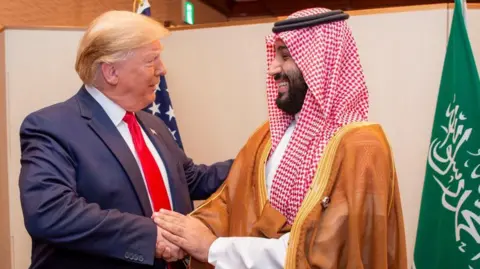**Trump Seeks Increased Gulf Investment in the US: Key Highlights from the Upcoming Visit**
As US President Donald Trump prepares for his imminent visit to Gulf states, securing substantial investments for the American economy stands out as a crucial agenda item. Scheduled to arrive in Riyadh, Saudi Arabia on May 13, Trump aims to enhance financial ties with the region’s prosperous nations, which have significant sovereign wealth funds ready for potential investment in the United States.
According to economist Karen Young from the Middle East Institute, Trump is keen on manifesting these investments at a meeting, showcasing how these funds can bolster the domestic economy, especially in job creation and manufacturing. This visit is particularly pivotal as it marks Trump’s return to the region for investment discussions, his first being during his presidency’s initial term where he broke the contemporary trend of starting visits to the UK or Canada.
The visit’s itinerary includes attending a summit with Gulf leaders on May 14, followed by a trip to Qatar, and concluding on May 15 in the United Arab Emirates (UAE). This three-day trip underscores the economic importance Trump places on enhancing ties with Gulf nations, especially Saudi Arabia—his first international destination during his initial term in office.
**Investment Opportunities and Economic Setting**
Highlighting the significance of this visit is the backdrop of economic headwinds. The Trump administration’s recent imposition of new tariffs has disrupted global trade, leading to a decline in US economic output for the first quarter of the year—a first in three years. Young observes that acquiring new investments from Gulf states, particularly state-backed sovereign wealth funds, would signal domestic success to his “America First” agenda and could potentially mitigate these economic challenges.
The Saudi-US investment forum on May 13 in Riyadh is expected to draw elite figures from Wall Street and Silicon Valley, including CEOs from major companies like BlackRock, Palantir, Citigroup, IBM, Qualcomm, Alphabet, and Franklin Templeton. The discussions are anticipated to yield significant economic agreements, enhancing the integration of Saudi and US economies in various sectors.
**Ambitious Goals for Investment**
Back in January, Saudi Crown Prince Mohammed bin Salman outlined a proposal for a $600 billion investment in the US over several years, which Trump aims to magnify to $1 trillion. This investment strategy may include the procurement of military equipment, further emphasizing the close US-Saudi security relationship. Ali Shihabi, a Saudi commentator with government ties, indicates that numerous economic agreements could be finalized during Trump’s trip, aimed at the dual goals of securing American military contracts and facilitating joint ventures in both nations.
The ongoing discussions reflect the evolving landscape of American arms sales to Saudi Arabia. Despite previous administrations imposing restrictions, the current White House aims to streamline processes to ensure timely access to military equipment, a move some Saudi officials expect to significantly enhance their defense procurement capabilities.
Furthermore, technology and artificial intelligence (AI) are high on the agenda during Trump’s visit. As both Saudi Arabia and the UAE invest heavily in diversifying their economies beyond oil—particularly in tech and AI sectors—Trump’s administration has recently lifted restrictions that could enable more seamless trade in high-tech semiconductor components.
**US-Saudi Business Council and Future Collaborations**
The US-Saudi Business Council aims to foster increased trade relations between the two nations and sees Trump’s visit as an opportune moment to encourage American businesses to explore opportunities in Saudi Arabia, particularly in emerging sectors like healthcare and education. Huthaim Al Jalal, head of the Riyadh office for the organization, suggests that the Saudi government is eager to collaborate with American companies, presenting a favorable environment for fruitful partnerships.
For Saudi Arabia, strengthening ties with the US remains vital, particularly following a strain in relations during the Biden administration. This trip is not merely about attracting American investment; it’s also about reaffirming Saudi Arabia’s long-standing alliance with its most significant Western partner.
In conclusion, Trump’s anticipated visit to the Gulf is emblematic of mutual interests—Saudi Arabia’s quest for economic diversification alongside the US’s search for global capital infusion. As Trump aims to cement investment deals that could reinforce his economic agenda, Saudi leaders are equally keen on establishing critical partnerships to further enhance their economic future under Vision 2030, further diversifying their income sources away from oil dependence.



